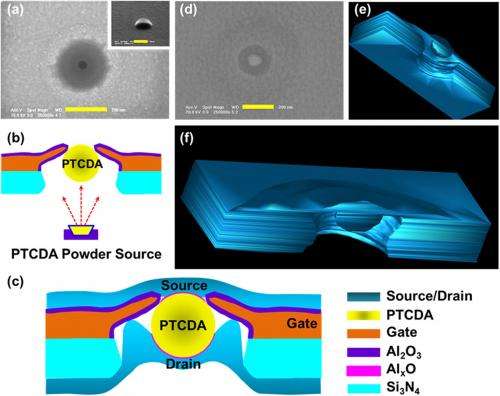November 15, 2013 feature
Organic semiconductor transistor made of a single nanoparticle achieves highest mobility yet

(Phys.org) —Organic semiconducting devices have many positive attributes, such as their low cost, high flexibility, light weight, and ease of processing. However, one drawback of organic semiconductors is that they generally have a low electron mobility, resulting in a weak current and poor conductivity.
In a new study, scientists from Taiwan have designed and built an organic semiconductor transistor with a mobility that is 2-3 orders of magnitude higher than that of conventional organic semiconductor transistors. The benefits of a high mobility could extend to a wide range of applications, such as organic LED displays, organic solar cells, and organic field-effect transistors.
The researchers, in a collaboration of the groups of Prof. CD Chen from Academia Sinica and Prof. MT Lin from National Taiwan University, have published their paper on the new high-mobility organic semiconductor in a recent issue of Applied Physics Letters.
The biggest reason for low electron mobility in conventional organic semiconductors is electron scattering due to structural defects in the form of grain boundaries. By designing an organic semiconductor transistor containing only a single grain, the scientists could avoid the problem of grain boundary scattering.
In their experiments, the researchers demonstrated that a device containing a single organic nanoparticle (perylene tetracarboxylic dianhydride, PTCDA) embedded in a nanopore and surrounded by electrodes achieves the highest electron mobility value to date by 1 order of magnitude, and is 2-3 orders of magnitude higher than the values reported for conventional organic semiconductor transistors made of polycrystalline films. The new device's mobility values are 0.08 cm2/Vs at room temperature and 0.5 cm2/Vs at a cool 80 K, which are approaching the intrinsic mobility of PTCDA.
In addition to its high mobility, the new organic semiconductor transistor also offers the highest external quantum efficiency reported to date. The researchers attribute this property to the use of a single nanoparticle in the device, but for reasons other than reducing grain boundary scattering. Instead, the nanoparticle's large surface area and small size, resulting in a short traveling distance for electrons, provide the high quantum efficiency. As a measure of a device's electrical sensitivity to light, a high quantum efficiency is useful for solar energy applications.
Altogether, the improved properties of organic semiconductor transistors could have far-reaching implications in electronic and opto-electronic devices.
"High-mobility organic materials have potential applications in flexible displays such as Active Matrix Organic Light Emitting Diodes (AMOLEDs) in commercial smartphones, digital cameras, TVs and a paper-like display or an electronic paper," Lin told Phys.org. "Another application of high-mobility organic material is to make field-effect-transistors for large-area flexible sensors such as pressure sensors for electronic artificial skin in a future generation of robots."
In the future, the researchers plan to further investigate the properties of single nanoparticles and other semiconducting materials.
"An immediate possibility for the solid-state gated-nanopore devices is for study of electronic and optoelectronic properties of single semiconducting nanoparticles," Lin said. "In addition, we also use this platform for exploring perpendicular-to-plane electron transport properties of atomic-layer materials such as transition metal dichalcogenides. Study on spin-dependent transport with magnetic electrodes will be another interesting topic for the potential application for organic spintronic devices. We believe this would provide useful information concerning fundamental characteristics of these interesting materials."
More information: Linh-Nam Nguyen, et al. "High performance phototransistors based on single crystalline perylene-tetracarboxylic-dianhydride nanoparticle." Applied Physics Letters 103, 183301 (2013). DOI: 10.1063/1.4827975
Journal information: Applied Physics Letters
© 2013 Phys.org. All rights reserved.



















